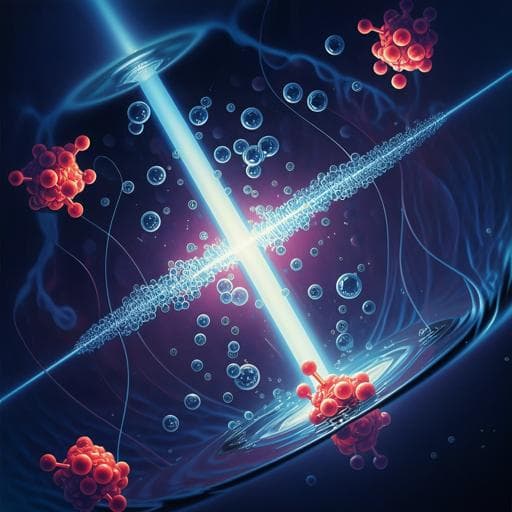
Chemistry
Hydrogen evolution with hot electrons on a plasmonic-molecular catalyst hybrid system
A. Dey, A. Mendalz, et al.
This exciting research, conducted by authors including Ananta Dey and Amal Mendalz, reveals the groundbreaking use of plasmon hot electrons for hydrogen evolution under visible light. The study highlights how a unique nanohybrid system enhances proton-electron transfer, paving the way for advanced solar energy solutions.
~3 min • Beginner • English
Introduction
The study addresses a long-standing question in plasmonic photocatalysis: do hot carriers (particularly hot electrons generated by plasmon decay) directly drive catalytic reactions, or are observed enhancements predominantly photothermal? Hot carriers relax on ultrafast timescales (~1 ps), complicating direct mechanistic attribution and making thermal effects difficult to exclude due to challenges in measuring nanoscale surface temperatures. The authors hypothesize that plasmon-induced hot electrons can directly mediate the hydrogen evolution reaction (HER) when appropriately coupled to a molecular catalyst, while heat contributes only secondarily. To test this, they design a hybrid NiO/Au/[Co(phen-NH2)2(H2O)2] system in which the catalyst is unstable at thermolysis temperatures, thus inherently limiting the possibility of heat-driven water splitting. NiO serves as a hole acceptor and the cobalt complex as an electron acceptor. The goal is to disentangle hot-carrier effects from photothermal and near-field contributions using a combination of photoelectrochemistry, ultrafast unbiased spectroscopies (TAS, TIRAS), and in situ NAP-XPS.
Literature Review
Background literature documents plasmonic hot-carrier participation in diverse reactions (solar-to-chemical conversions, epoxidations, dehydrogenations, ammonia synthesis), yet skepticism persists due to ultrafast carrier relaxation and difficulties distinguishing hot-carrier catalysis from photothermal processes. Prior work highlights broad, non-Fermi–Dirac hot-carrier energy distributions and their rapid relaxation, while also showing that ultrafast charge transfer to suitable acceptors can outcompete relaxation. Methods to distinguish thermal from nonthermal effects have been proposed, emphasizing careful controls. A recent related report used a cobalt porphyrin on plasmonic nanoparticles for H2 generation, but in that system both catalyst and Au NPs were photoactive, leaving open interpretations such as photonic enhancement and mixed hot-carrier/thermal effects. In contrast, the present work uses only Au NPs as the photoactive component, providing a more stringent test of direct hot-electron involvement and offers more extensive experimental support for a ligand-mediated mechanism in cobalt HER systems, differing from traditional metal-centered pathways.
Methodology
- Materials and assembly: The hybrid photosystem comprises mesoporous NiO films on FTO (screen-printed Solaronix NiO paste; annealed 500 °C, 1 h), Au nanoparticles (Turkevich synthesis; average 8±2 nm; sprayed onto NiO and annealed 500 °C, 1 h), and a cobalt molecular catalyst [CoII(1,10-phenanthrolin-5-amine)2(H2O)2] anchored to Au via amino groups by immersion in 4 mg/mL aqueous solution for 3 days followed by rinsing.
- Catalyst synthesis: Reflux 1,10-phenanthrolin-5-amine with Co(NO3)2·6H2O in ethanol; isolate red product (yield 73.9%); ATR-IR bands include N–H stretches (ca. 3342, 3402 cm−1).
- Characterization: UV-Vis of catalyst (strong 290 nm band, shoulder at 360–370 nm). Water titration confirms nitrate–water ligand exchange (UV-Vis increase at 360 nm; XPS shows pyridinic N at 398.6–398.8 eV; no nitrate N at ~408 eV). Au LSPR at 535 nm shifts to lower energy upon catalyst binding; IR shows disappearance of N–H stretching bands after anchoring (coordination via –NH2 groups). UHV-XPS before/after anchoring: N 1s –NH2 peak at 401.4 eV vanishes after binding; phenanthroline N shifts/broadens (to ~399.1 eV); Au 4f7/2 remains at 83.6 eV (metallic Au), consistent with delocalized electronic coupling.
- Electrochemistry: Conducted with EmStat potentiostat in a closed cell. Supporting electrolyte 0.1 M LiCl; proton source 3 mM acetic acid (pH ~3.5) unless noted; Ag/AgCl reference; Pt wire counter. Bulk electrolysis on glassy carbon WE to probe catalyst redox; thin-film CV/chronoamperometry on FTO/NiO/Au/Co-cat under 532 nm CW illumination (43.8 mW/cm²; area 0.79 cm²). Off-resonance tests at 650 nm.
- Gas analysis: Online quadrupole mass spectrometry (Hiden HPR 20) under Ar flow (15 mL/min) for H2 detection during photoelectrochemistry.
- Ultrafast spectroscopy (unbiased): TAS (pump 550 nm; probe 400–750 nm; 40 fs pulses, 3 kHz; IRF ~95 fs) to extract electron–electron (e–e) and electron–phonon (e–ph) lifetimes from LSPR bleach dynamics. TIRAS (pump 550 nm; mid-IR probe 3000–10000 nm; IRF ~100 fs) to detect free-carrier absorption and extract injection/recombination kinetics.
- In situ NAP-XPS: PHOENIX I beamline (SLS), solid–liquid interface endstation, three-electrode setup; tender X-rays (5000 eV). Dip-and-pull adaptation for mesoporous films to maintain a thin electrolyte layer. Spectra: O 1s (liquid water ~532.7–532.8 eV; hydroxyls ~531.0 eV; gas-phase water ~534.9 eV; occasional lattice O at ~529.5 eV), Co 2p (Co2+ ~780 eV). Potential control verified via voltage-proportional shifts in the liquid-water O 1s component. Peak fitting with Shirley background and literature-constrained components. ICP-OES used to quantify Co loading (11.4 µg/cm²; 0.29 wt.%).
Key Findings
- Catalytic activity and light response: Under 532 nm illumination at −0.65 V vs Ag/AgCl (3 mM acetic acid, 0.1 M LiCl), NiO/Au/Co-catalyst shows an increase in photocurrent of ~−15 µA (−19 µA cm−2) relative to dark. Estimated H2 production rate: 3.1 nmol/(min·cm²) from repeated light on/off cycles; hydrogen evolution confirmed by QMS. Stability maintained over ~360 min on/off cycling. Control systems (NiO/Au or NiO/Au/ligand) exhibit negligible photocurrent and no detectable H2.
- Electrochemistry: Bulk electrolysis of the cobalt catalyst in water (0.1 M LiCl) shows no distinct Co-centered reduction peaks prior to catalytic wave onset at −1.18 V vs Ag/AgCl. Addition of 3 mM acetic acid shifts onset by up to ~120 mV and increases catalytic wave amplitude, consistent with concerted proton–electron transfer (CPET) steps rather than sequential electron then proton transfers. On NiO/Au, a reduction peak at ~−0.49 V (surface oxygen reduction on Au) is strongly suppressed upon catalyst attachment, indicating surface functionalization.
- Near-field and photothermal controls: Off-resonant excitation at 650 nm yields no significant change in CV or chronoamperometry versus dark, indicating negligible direct near-field catalytic contribution. Light-modulation chronoamperometry shows current transients inconsistent with heat-dominated behavior: Δi does not scale with t² and lacks linear dependence on light exposure time. Removing NiO (Au/Co-cat) produces slower, heat-like current rise/decay and a smaller light-induced current, while the full NiO/Au/Co system shows faster transients indicative of hot-carrier mediation; NiO improves charge separation by accepting holes, reducing heat generation.
- Ultrafast TAS (550 nm excitation, 490 nm probe region): Au NPs on glass: e–e 167±49 fs; e–ph 5.1±0.4 ps. NiO/Au: e–e 198±85 fs; e–ph 3.4±1.0 ps (hole transfer to NiO shortens e–ph). Au/Co-cat: e–e 148±30 fs; e–ph 4.2±0.3 ps (electron transfer to catalyst shortens e–ph). Complete NiO/Au/Co-cat: e–e 198±116 fs; e–ph 2.6±1.0 ps (largest reduction), consistent with simultaneous hot-hole and hot-electron extraction.
- Unbiased TIRAS (mid-IR free-carrier absorption near 4705 nm): NiO/Au shows fast injection (196±104 fs) and predominant recombination within 417±117 fs (~91%). Complete system shows similar injection (100±23 fs) but much longer recombination component (6.6±4.2 ps, ~85%), and increased amplitude, indicating enhanced charge separation; 5–10% of carriers persist >1 ns, sufficient for catalysis. Systems without NiO (Au/ligand and Au/Co-cat) still display broad free-carrier signatures; rapid electron injection into ligands occurs within the IRF (~100 fs), with slower decay when Co is present (charge stabilization), supporting light-driven ligand reduction even without external bias.
- In situ NAP-XPS: Co 2p3/2 remains at ~780 eV (Co2+) across applied potentials, with no detectable shift to Co0 (~778 eV), both with and without acid. At −0.65 V (H2 evolution onset), Co signal intensity decreases due to bubble formation and experimental conditions but no new Co species are resolved. O 1s liquid-water peak shifts with applied potential, validating electrochemical control. These observations suggest cobalt reduction/protonation steps are too fast to resolve and that ligand-centered reduction precedes rapid CPET to Co during H2 evolution.
- Structural and anchoring evidence: UV-Vis LSPR red-shift upon catalyst binding; disappearance of N–H IR bands after anchoring; UHV-XPS N 1s changes (loss of 401.4 eV amino component) consistent with Au–N coordination via amines; Au remains metallic (Au 4f7/2 83.6 eV).
Discussion
The combined electrochemical, optical, ultrafast spectroscopic, and in situ XPS data indicate that 532 nm excitation of Au nanoparticles generates hot carriers that are extracted to distinct acceptors: holes to NiO and electrons to the phenanthroline ligands of the cobalt complex. The absence of Co-centered reduction waves in bulk electrolysis, the TIRAS free-carrier signatures for ligand reduction on ultrafast timescales, and the shortened e–ph lifetimes in TAS collectively support direct hot-electron injection into ligands. Control experiments rule out significant direct near-field-driven catalysis and show that thermal effects alone cannot account for the observed kinetics or magnitude of the photocurrent; heat contributes positively but is not the primary driver. NiO serves to accept hot holes, extending charge-separated lifetimes and enhancing catalytic efficiency while diminishing photothermal contributions. In situ NAP-XPS under potential shows Co staying predominantly as Co2+, implying that any reduction/protonation events at Co during catalysis are transient and rapid, consistent with a mechanism where ligand-centered reduction is followed by concerted proton–electron transfer to the metal center, culminating in H2 evolution. The response to light modulation further distinguishes hot-carrier-mediated catalysis from thermal processes, aligning with a mechanism in which hot electrons in the ligand framework facilitate rapid CPET steps that lower energetic barriers and avoid high-energy intermediates.
Conclusion
This work demonstrates direct involvement of plasmon-generated hot electrons in driving the hydrogen evolution reaction in a tailored NiO/Au/[Co(phen-NH2)2(H2O)2] hybrid. By using a molecular catalyst unstable at thermolysis temperatures, off-resonant controls, light-modulation kinetics, unbiased ultrafast TAS/TIRAS, and in situ NAP-XPS, the study isolates hot-carrier effects from photothermal and near-field contributions. The key mechanistic insight is that hot electrons are injected into phenanthroline ligands, which then engage in rapid concerted proton–electron transfer steps to reduce and protonate the cobalt center, producing H2; NiO accepts hot holes and enhances charge separation. The approach resolves debates on hot-carrier participation in plasmonic photocatalysis and provides a methodology applicable to mesoporous, realistic electrodes. Future work could directly track transient Co–H hydride formation with higher time-resolution operando X-ray/IR spectroscopies, optimize ligand–metal coupling to further extend hot-carrier lifetimes, quantify nanoscale temperature profiles under operation, and explore generalization to other catalytic transformations and metal–ligand architectures.
Limitations
- Signal-to-noise constraints due to low cobalt loading (11.4 µg/cm²; 0.29 wt.%) and mesoporous electrode geometry complicate spectroscopic detection of weak or transient species (e.g., Au–N by Raman undetectable).
- NAP-XPS temporal resolution and attenuation through the electrolyte layer preclude observation of ultrafast, transient Co redox/protonation events during H2 evolution; bubble formation at high cathodic bias further reduces signal intensity.
- Exact quantification of nanoscale surface temperatures under plasmonic excitation remains challenging; while controls indicate heat is not dominant, a small positive thermal contribution cannot be fully excluded or precisely apportioned.
- Quasi-transparent electrodes hindered conventional light-intensity modulation studies, necessitating repetition-rate modulation which may have different sensitivities to thermal dynamics.
- Off-resonant tests and controls minimize but cannot absolutely eliminate subtle near-field-assisted effects on carrier dynamics.
Related Publications
Explore these studies to deepen your understanding of the subject.







